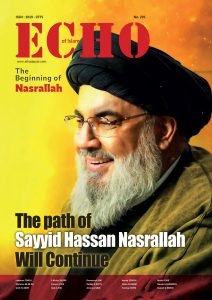‘Even if we are martyred, our houses demolished over our heads we will not abandon the choice of Islamic Resistance’
Sayyid Hassan Nasrallah was born in 1960 to a poor Shia family in Sharshabouk, a deprived area of east Beirut’s Karantina. He underwent his primary education in his hometown and completed his secondary education in Bazourieh, a rural area in southern Lebanon in 1976.
Being interested in religious studies he left for Najaf in Iraq and after 2 years of staying and studying in this city, he returned to Lebanon again and started learning seminary sciences at Al-Imam Montazar School in Baalbek. His main encourager for going to Najaf and learning Islamic sciences was Sayyid Mohammad Gharavi, Imam of the city of Tire.
In December 1976, Nasrallah left for Najaf in Iraq to study at the city’s religious seminary (hawzah), which advocated a more active role for Shia religious scholars. There, he met Lebanese scholar Sayyid Abbas Mousavi, who was studying under Sayyed Mohammad Baqer Sadr, a cousin of Musa Sadr. In early 1978, an Iraqi Baathist crackdown on Shia forced Nasrallah and Mousavi back to Lebanon. Mousavi founded a religious seminary in Baalbeck, where Nasrallah continued studying.
Nasrallah, whose speeches attracted attention from across the Middle East and beyond, was long prominent in the Axis of Resistance, which includes Hezbollah, the Palestinian movements Hamas and Islamic Jihad, the Houthi movement in Yemen, and several Iraqi paramilitary groups.
In 1981, Nasrallah went to Qom to complete his seminary studies, but a year later, due to the intensity of tensions in Lebanon, he returned to Beirut at the request of the Hezbollah Council.
In the meeting that Sayyid Hassan Nasrallah had with Imam Khomeini (RA) in Tehran, Imam Khomeini (RA) appointed him as his representative with regard to Hasbiyyah affairs (Enjoining good and forbidding wrong) and Shariah affairs (receiving religious taxes) in Lebanon. He was just 21 years old when he received this authority from Imam Khomeini (RA).
He was also inspired by Sayyid Musa Sadr, an Iranian-born imam of Lebanese descent – who had, in the spring of 1974, launched the Movement of the Deprived, better known as Amal – to secure more power for Lebanon’s neglected Shia community and improve conditions in east and south Lebanon.
Foundation of Hezbollah
Following the Israeli attacks on southern Lebanon in 1982, and after the kidnapping of Imam Musa Sadr, certain politicalmilitary differences erupted between the leaders of the Amal movement, as a result of which Sayyid Hassan – along with some other officials of the Amal movement, led by Sayyid Abbas Mousavi, who had inclinations towards the Iranian Revolution – left this group, which actually became a prelude to the establishment of the initial core of Hezbollah under the leadership of Mousavi in the same year.
Positions
Sayyid Hassan Nasrallah has been active in Hezbollah since the beginning of its formation in 1985 he took on heavier responsibilities by moving to Beirut. Nasrallah’s first serious responsibility was to prepare the resistance forces and establish military units, and at the same time, he was the deputy of Ibrahim Amin, one of the representatives of Hezbollah in the Lebanese Parliament. In 1987, Nasrallah was elected as the chairman of the executive committee of Hezbollah. At the same time, he also joined Hezbollah’s decision-making council and was its executive officer.
In 1982, Hezbollah launched a successful guerrilla warfare to drive Israel from Lebanon. It said this was a prelude to freeing historic Palestine, occupied by Zionist settlers.
After the assassination of Sayyid Abbas Mousavi by Israeli airstrikes on February 16, 1992, with the consensus of Hezbollah’s decision-making council, Hassan Nasrallah was elected as the Secretary General of Hezbollah.
Speaking at the funeral of Sayyid Abbas Mousavi, Nasrallah said: “We will continue this path… even if we are martyred, all of us and our houses demolished over our heads, we will not abandon the choice of the Islamic Resistance.”
Under Nasrallah, whose surname translates as “victory through God”, Hezbollah grew from a local armed movement to the largest political party in Lebanon’s recent history. In the 2018 parliamentary elections, Hezbollah won more than 340,000 preferential votes, the most for any party in Lebanon since independence.
Nasrallah, whose speeches attracted attention from across the Middle East and beyond, was long prominent in the Axis of Resistance, which includes Hezbollah, the Palestinian movements Hamas and Islamic Jihad, the Houthi movement in Yemen, and several Iraqi paramilitary groups.
Under Nasrallah’s leadership of Hezbollah, modern Lebanon was able to militarily defend itself against Israel.
Nasrallah enjoyed wide respect and support among many Lebanese, especially Shia and those in south Lebanon, especially for his humble lifestyle. Much of this relates to how Hezbollah has become a major regional military force, driving Israel out of south Lebanon. Supporters say Lebanon’s south has been able to enjoy two decades of unprecedented peace.
Sayyid Hassan Nasrallah was martyred at the age of 64 in a series of cowardice Israeli air strikes in south Beirut on September 27, 2024.
View this article in Echo of Islam 291




